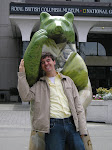Andrew Rudin has all the hallmarks of a real musical craftsman. His colorful effects are expertly conceived and carefully timed, his rhythms are alternatingly intense and ruminative, and his large and small-scale gestures are clear and deliberate. His aesthetic offers a compelling combination of old-school technique and eminently listenable appeal.
A concert last Sunday at Swarthmore College provided another chance to take in Rudin's work, with a performance of Celebrations for two pianos (Marcantonio Barone and James Freeman) and percussion (Anthony Orlando). Although other movements and indeed other compositions were also featured, the first movement of Celebrations is available online!
Take a listen to the rehearsal, or, if Facebook allows, watch the performance itself.
A low, creeping piano melody sets the stage for the initial section lasting three-and-a-quarter minutes. Soft metallic percussion insinuates itself subtly into the mix, brightening the tone just a bit. A second formal area, announced by a strident triangle, raises the pitch clearly out of the basement. Vaguely quartal harmonies predominate with a health mixture of biting dissonances besides. Perhaps not coincidentally, this section is of identical length as the first.
Just over half way through the movement, a pulsating figure in marimba and piano provides a rhythmic vitality familiar to Rudin listeners. This underlies a lovely, angular melody that turns both sweet and brilliant. Nearly nine minutes in, the percussion swells to deliver the dynamic peak of the work.
From the ensuing silence, a single bowed vibraphone melts into a tight piano trill, signaling the start of the final section. Similar calculated and recognizable "color moments" can be found in many of Rudin's works and are a real joy to hear. Gradually, the music works itself back to a stoicism reminiscent of the opening. Vibraphone bell-tones are answered by low tolling in the pianos. Ultimately, the work winds down to the same place it started: with a simple, delicate tolling of single notes, ending on a low E natural - the same pitch that began the Celebrations eleven minutes before.
And that's only the first movement!
Reminder: You can get a quick list of all my reviews by going here... OR, through my website's handy Review gadgets. Enjoy, and come back tomorrow for a Celebrations-inspired haiku!
Sunday, December 20, 2009
Review: Rudin's Celebrations (mov.1) at Swarthmore - Dec 13
Labels:
Andrew Rudin,
chamber music,
contemporary music,
new music,
reviews
Subscribe to:
Post Comments (Atom)


No comments:
Post a Comment